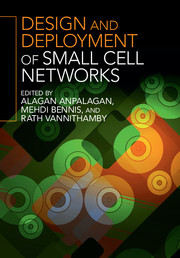Book contents
- Frontmatter
- Contents
- List of contributors
- Preface
- 1 Mobility performance optimization for 3GPP LTE HetNets
- 2 Design and performance analysis of multi-radio small cell networks
- 3 Dynamic TDD small cell management
- 4 3GPP RAN standards for small cells
- 5 Dense networks of small cells
- 6 Traffic offloading scenarios for heterogeneous networks
- 7 Required number of small cell access points in heterogeneous wireless networks
- 8 Small cell deployments: system scenarios, performance, and analysis
- 9 Temporary cognitive small cell networks for rapid and emergency deployments
- 10 Long-term evolution (LTE) and LTE-Advanced activities in small cell networks
- 11 Game theory and learning techniques for self-organization in small cell networks
- 12 Energy efficient strategies with BS sleep mode in green small cell networks
- 13 Mobility management in small cell heterogeneous networks
- 14 The art of deploying small cells: field trial experiments, system design, performance prediction, and deployment feasibility
- 15 Centralized self-optimization of interference management in LTE-A HetNets
- 16 Self-organized ICIC for SCN
- 17 Large-scale deployment and scalability
- 18 Energy efficient heterogeneous networks
- 19 Time- and frequency-domain e-ICIC with single- and multi-flow carrier aggregation in HetNets
- Index
- References
6 - Traffic offloading scenarios for heterogeneous networks
Published online by Cambridge University Press: 05 December 2015
- Frontmatter
- Contents
- List of contributors
- Preface
- 1 Mobility performance optimization for 3GPP LTE HetNets
- 2 Design and performance analysis of multi-radio small cell networks
- 3 Dynamic TDD small cell management
- 4 3GPP RAN standards for small cells
- 5 Dense networks of small cells
- 6 Traffic offloading scenarios for heterogeneous networks
- 7 Required number of small cell access points in heterogeneous wireless networks
- 8 Small cell deployments: system scenarios, performance, and analysis
- 9 Temporary cognitive small cell networks for rapid and emergency deployments
- 10 Long-term evolution (LTE) and LTE-Advanced activities in small cell networks
- 11 Game theory and learning techniques for self-organization in small cell networks
- 12 Energy efficient strategies with BS sleep mode in green small cell networks
- 13 Mobility management in small cell heterogeneous networks
- 14 The art of deploying small cells: field trial experiments, system design, performance prediction, and deployment feasibility
- 15 Centralized self-optimization of interference management in LTE-A HetNets
- 16 Self-organized ICIC for SCN
- 17 Large-scale deployment and scalability
- 18 Energy efficient heterogeneous networks
- 19 Time- and frequency-domain e-ICIC with single- and multi-flow carrier aggregation in HetNets
- Index
- References
Summary
This chapter considers the challenges faced by network operators and service providers accommodating the increasing traffic demands in cellular networks in the most efficient yet inexpensive way. It proposes that these challenges are addressed by offloading part of the traffic to femto cell access points (FAPs) and WiFi access points (WiFiAPs). Whereas 4G micro and pico cell base stations are assumed to be managed by the network operator in terms of setup and maintenance, FAPs and WiFiAPs are normally bought and operated by the end-user. The main difference between these two solutions is that the FAPs operate on the frequency bands assigned to the network operator by national regulators, while WiFiAPs work on unlicensed spectrum. This chapter analyzes the pros and cons of such approaches, and the tradeoffs related to the different mechanisms employed in cellular and WiFi networks for interference management. Moreover, various methods for traffic offloading by the mobile network operator are discussed in detail, including local IP access (LIPA), selective IP traffic offloading (SIPTO), IP flow mobility (IFOM), access network discovery and selection function (ANDSF), and Hotspot 2.0, etc. In the experimental part of this chapter, means for traffic management from the network operator's perspective are discussed, taking into account costs and energy savings. Furthermore, a novel resource usage coordination concept in conjunction with the WiFi offloading concept is presented.
Introduction
The traffic served by cellular networks grows significantly on a yearly basis, making the efficient, fair, and inexpensive management of users’ traffic demands a real challenge. Various forecasts provided both by legal bodies and commercial companies show that this trend will not change in the future. One can, for example, consider the expectations provided in Table 6.1, created based on the data delivered in the Cisco Visual Networking Index [1, 2] in 2012 and 2013. It is shown that the monthly average traffic generated by mobile devices is foreseen to grow exponentially. Based on [3], it can be stated that in 2017 IP traffic originating from mobile devices will comprise more than 13% of fixed IP traffic, while in 2013 this comprised only around 4% of fixed IP traffic.
- Type
- Chapter
- Information
- Design and Deployment of Small Cell Networks , pp. 122 - 147Publisher: Cambridge University PressPrint publication year: 2015



